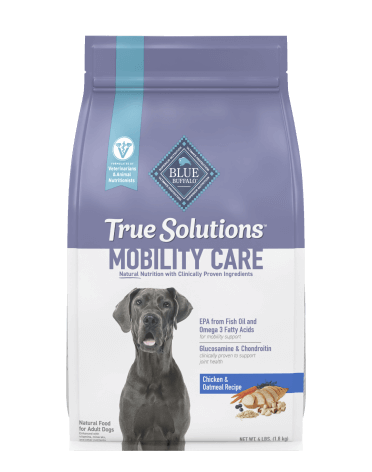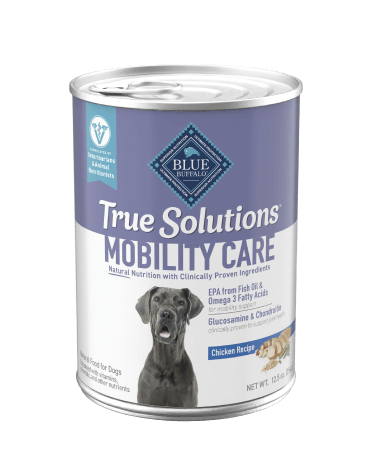What causes joint pain in dogs?
Like athletes, the more some dogs run and jump, the more their joints suffer wear and tear. This can lead to injuries that cause joint-related conditions including osteoarthritis.
Problems like hip or elbow dysplasia can cause joints to develop incorrectly. Joint pain can also occur from degenerative problems and ligament tears, such as ACL tears, which are commonly diagnosed in dogs and can also result in arthritis.
Signs that your dog may have joint pain:
- He’s less active or has difficulty doing normal activities
- No more couch potato; your dog can’t get up there anymore
- He can’t climb up the stairs or get into cars easily
- He can’t outrun you anymore
- He tires easily, doesn’t like playing with his pals
- He holds one of his limbs awkwardly
Are some dogs more prone to joint pain than others?
Large dogs such as Newfoundlands, Rottweilers and Bernese Mountain dogs can have breed-specific joint problems. Their increased size and weight make them poster dogs for both developmental and degenerative problems. But any dog that gains too much weight can start showing signs of joint pain, which is why it’s important to help your dog stay fit.
Dogs who have an ideal weight and avoid obesity put less stress on their joints, so weight control and routine exercise are key non-surgical treatments to avoid chronic joint pain.
How can I help my dog avoid joint problems?
Since an ideal weight is paramount, diet is the first important change you can make to help mitigate your dog’s joint pain. Make sure your veterinarian routinely weighs your dog. A wholesome diet that includes nutrients like glucosamine for dogs can help your best buddy keep his joints strong.
Staying active also helps dogs avoid obesity. Exercise is necessary at all ages, but especially when your dog is older. A daily exercise regimen can help lubricate your dog’s joints and decrease his stiffness. Ask your veterinarian to recommend safe exercises for dogs who have joint pain, especially if your dog is older.
Your veterinarian may suggest low-impact exercises that can still provide a good workout:
- Walking: Dogs love to walk, especially when they’re younger and healthier. But dogs who suffer from joint pain and arthritis can benefit from shorter walks, a couple of times a day depending on how much pain they have. Avoid long walks of 30-minutes or more, and give your dog time to recover between strolls if you go out more than once daily.
- Moderate activity: Running and jumping to catch frisbees and balls can put a strain on your dog’s joints. Replace strenuous activities like those with more moderate ones where your dog doesn’t have to work as hard to play with his favorite toys.
- Dive in! Water-based activities like swimming have been scientifically proven to decrease the impact on your dog’s joints. Take your buddy to a dog-friendly beach or lake if you can’t access a pool. If your veterinarian approves, you may want to schedule hydrotherapy sessions with professional rehabilitation specialists.
Provide all the comforts of home.
As your dog ages, pay attention to his environment. Is it easy to navigate? Is his mobility restricted in any way? You may need to consider a few changes that can help.
- All about bedding: From memory foam to heated and orthopedic beds there are a lot of comfortable choices you can find to help alleviate your dog’s hip and joint pain.
- Check the floor: Do you have hardwood, tile or other slippery floors that make it difficult for your dog to maneuver? Adding non-slip rugs or pads where your dog treads the most could help him travel more safely and easily.
- Ramp up: Whether you take road trips with your dog or he cuddles with you in bed, try car or bed steps to make his climb easier. Adding a ramp can help even more if your dog has frail joints.
- Lots of TLC: As joint pain increases, your dog won’t be able to do everything he loves, so showering him with extra attention can help soothe him if he’s irritable. You can even treat your dog to acupuncture, a professional massage or learn some gentle techniques on your own to relieve joint pain and stiffness.
Massage can help increase your dog’s circulation, flexibility, and if done regularly throughout his life, may even help decrease the stiffness that contributes to arthritis in dogs. Whether you massage your dog or not, most dogs love to be cuddled and nothing beats that time for bonding, which is therapeutic for both of you.



